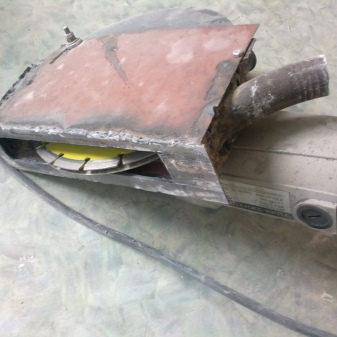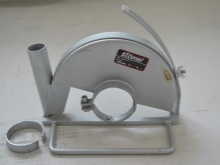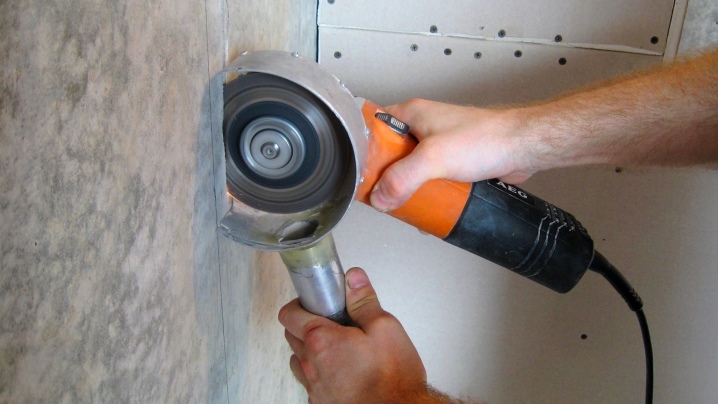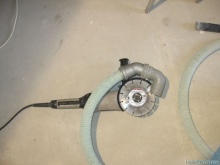Do-it-yourself wall chaser

A wall chaser is a type of cutting tool that allows you to perfectly smoothly make grooves in the wall for wiring, steel busbars for grounding, etc. This is an indispensable thing for those who want to hide the "engineer" in the wall.

Making from a grinder
A self-made wall chaser from an angle grinder is ingeniously simple. To organize high-speed and high-quality cutting of grooves in the wall for hidden wiring, it is necessary to perform certain actions.
- Prepare two identical discs for concrete, stone and brick.
- Remove the casing from the grinder and secure the first disc with a standard nut. Do not forget to first put on the fixing spacer on the axle of the Bulgarian gearbox (under the disc).
- Put the second disc on top of the standard nut (after the disc) - and secure it with the second nut. If there is no spare standard nut, purchase or order a ready-made nut from a turner, it should fit perfectly under the thread of the grinder's shaft.


Be sure to check whether both discs are securely fastened to prevent accidental loosening of the nuts and their falling off the angle grinder during operation. It is recommended to purchase a wider protective cover - or grind (or order from a milling machine) a suitable one. Both discs should not touch it during operation.
Be sure to use protective ammunition: coarse cloth overalls, respirator. If you work without a casing, a protective helmet with a visor, additional goggles, boots, gloves made of coarse and thick fabric are strictly required. The fact is that chipping is a source of high-speed dust, which can fly off into the face, clog the eyes, ears and airways. The detachment of diamond particles when the disc overheats in the mode of gouging of stone and concrete can be dangerous in the form of irreversible clogging of the eyes during operation.


How to make from a drill?
The drive of a manual electric drill is a twisting mechanism, somewhat reminiscent of a grinder. The drill and hammer drill, in addition to the motor, are equipped with a reduction gearbox. The perforator mechanics also includes a shock-vibration mechanism.


To gouge a groove in concrete, stone, brick or cement, set the hammer drill to impact only, no rotation. The disadvantage is the low quality of the groove in the form of an uneven groove, which is a channel with significant depth differences. These differences do not allow, for example, to lay a cable duct (cable duct) in the wall - it is required to meticulously bring the shallower sections to the required level of the cutter's immersion. When laying a rectangular box or corrugated tube, the master periodically applies it to the channel to make sure that it fits into the wall along its entire length.
Due to uneven grooving after laying the cable duct or corrugation, a higher consumption of building materials for new plaster will be required than in the case of cutting with a "two-disc" machine.



Circular saw model
A circular saw in general resembles the mechanics of a grinder - it also has a direct- or gear-driven mechanism. The kit includes a union for fixing the saw blade to the shaft and a lock nut. The grinder is held by the body and the handle and is brought to the fixed material for further sawing and sawing. A circular saw, or a saw machine, is fixed motionlessly on a workbench.The material to be sawn (angle profile, strip steel, etc.) is fed to it, which, as it is cut, is pushed into the working space, where the disk rotates at high speeds. To make a wall chaser yourself from a circular, you must follow 4 steps sequentially.
- Remove the cover that protects the worker from the spread of high-speed particles of the material being cut. Most likely, it will not work - you will need at least twice as wide.
- Make a wider cover - for two saw blades.
- Put on the components in the following sequence: the retainer fitting, the first disc, one or more spacer washers, the second disc, and the locknut onto the drive shaft.
- Connect the corrugation or hose of the vacuum cleaner to the suction siphon.



Making a cover involves performing a number of steps step by step.
- Take the measurement (diameter of the circular working area of the saw) of the standard cover. Make a drawing based on the future requirements of the circular wall chaser.
- Cut off the handles (if any) from an old saucepan (a small steel enamel container is considered optimal, designed for portions for 2-3 meals per person).
- Cut a hole in the bottom of the pan that is slightly larger in diameter than the circular shaft.
- Weld a round brace or an annular flange, which is a collapsible clamp, around the perimeter of the slot. It resembles a wrap, which is part of the grinder's protective casing and pressed against the locating sleeve, in which the shaft rotates. If necessary, if there is no clamp, it can be bent to fit the seat of the standard circular casing. It is fixed with a clamping bolt.
- Cut a slot in the pan welded to the side, large enough for the rotating discs to be able to plunge into the wall cut along the "groove" by a few centimeters.
- From the lid of the pan, make the clip-on part of the cover. Thus, the worker will protect himself from particles flying out not only in the direction of rotation of the discs, but also from the side, where the discs are installed and removed. The fact is that high-speed crumbs from blocks, sawdust and shavings can bounce off the inner walls of the casing. Locks can be any - in the form of locks (such as thorn and groove), widely used, for example, in consumer electronics. Sometimes screw clamps are used based on a bolt and a nut with an engraving washer - the nut is installed on a special flange with bent edges, which is part of the casing. The master can choose any type and variety of latch.
- Arrange a connection for a dust extraction. In an arbitrary place (it does not really matter), cut a hole for an existing piece of steel pipe (or squeeze from an old heating battery). Weld it to this place, check the tightness of the resulting joint.

Check the assembled wall chaser in action. The particles should fly off only in a narrow stream - tangentially passing through the point of contact of the rotating discs with the material being cut. They should not scatter like a fan, in all directions. Plug in and start the vacuum cleaner - particles will be absorbed by its suction pipe, and not fly out.
Homemade additional accessories
As an accessory, in addition to the casing, press washers and locknuts, with which you can expand the standard completeness, an important component is also a technical dust extractor.
Shroud
A properly made casing should be a volumetric cylinder bounded by two cutting discs connected to the base by a locknut and spacer washers. If necessary, a spring (engraving) washer can be used, which serves as an additional tightening, which prevents the lock nut from unscrewing, and the discs and washers from flying off at full speed. Even if the diamond particles of the disks are torn off, one disk (or both at once) breaks or is chipped, the components fly off - the casing will take on all the force of the impact (and the vibration that arose at the same time).Flying components or a disc that is cracked at full speed can cause injury.

Check if the thickness of the steel from which you are making the casing is sufficient: its value should be at least 2 mm.
Vacuum cleaner
The purpose of the dust extractor is to prevent the destroyed building material from which the wall is built from scattering. Cement plaster is highly abrasive: contact with eyes, ears and respiratory tract is dangerous. A technical vacuum cleaner connected to the exhaust pipe of the casing will suck in any material: particles of concrete, brick, foam blocks, gas blocks, sand-cement plaster, gypsum, alabaster, lime, paint, etc.


The dust suction can be made from an old household vacuum cleaner, an inexpensive robotic vacuum cleaner that is compact. Craftsmen convert robotic vacuum cleaners for technical dust extractors. Their capacity is small - no more than 1 liter. This is enough to collect dust and debris when cutting a groove - along gas silicate or brick - with a length of 1–3 m. Empty the container (or bag) for collecting dust regularly - with a corresponding signal of the dust collector filling progress indicator.



How to make a wall chaser with your own hands, see the video.













The comment was sent successfully.